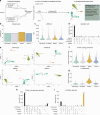Uncovering functional lncRNAs by scRNA-seq with ELATUS
- PMID: 39521797
- PMCID: PMC11550465
- DOI: 10.1038/s41467-024-54005-7
Uncovering functional lncRNAs by scRNA-seq with ELATUS
Erratum in
-
Author Correction: Uncovering functional lncRNAs by scRNA-seq with ELATUS.Nat Commun. 2025 Jan 7;16(1):452. doi: 10.1038/s41467-024-55730-9. Nat Commun. 2025. PMID: 39774948 Free PMC article. No abstract available.
Abstract
Long non-coding RNAs (lncRNAs) play fundamental roles in cellular processes and pathologies, regulating gene expression at multiple levels. Despite being highly cell type-specific, their study at single-cell (sc) level is challenging due to their less accurate annotation and low expression compared to protein-coding genes. Here, we systematically benchmark different preprocessing methods and develop a computational framework, named ELATUS, based on the combination of the pseudoaligner Kallisto with selective functional filtering. ELATUS enhances the detection of functional lncRNAs from scRNA-seq data, detecting their expression with higher concordance than standard methods with the ATAC-seq profiles in single-cell multiome data. Interestingly, the better results of ELATUS are due to its advanced performance with an inaccurate reference annotation such as that of lncRNAs. We independently confirm the expression patterns of cell type-specific lncRNAs exclusively detected with ELATUS and unveil biologically important lncRNAs, such as AL121895.1, a previously undocumented cis-repressor lncRNA, whose role in breast cancer progression is unnoticed by traditional methodologies. Our results emphasize the necessity for an alternative scRNA-seq workflow tailored to lncRNAs that sheds light on the multifaceted roles of lncRNAs.
© 2024. The Author(s).
Conflict of interest statement
The authors declare no competing interests.
Figures






References
-
- Rahman, R. U. et al. Singletrome: a method to analyze and enhance the transcriptome with long noncoding RNAs for single cell analysis. 10.1101/2022.10.31.514182.
-
- Zheng, L. L. et al. ColorCells: a database of expression, classification and functions of lncRNAs in single cells. Brief. Bioinform22, 1–11 (2021). - PubMed
Publication types
MeSH terms
Substances
Grants and funding
- LCF/PR/HR21/00176/"la Caixa" Foundation (Caixa Foundation)
- 0011-0537-2020-000038/Departamento de Educación, Gobierno de Navarra (Department of Education, Government of Navarra)
- 898356/EC | EU Framework Programme for Research and Innovation H2020 | H2020 Priority Excellent Science | H2020 Marie Skłodowska-Curie Actions (H2020 Excellent Science - Marie Skłodowska-Curie Actions)
LinkOut - more resources
Full Text Sources
Molecular Biology Databases

